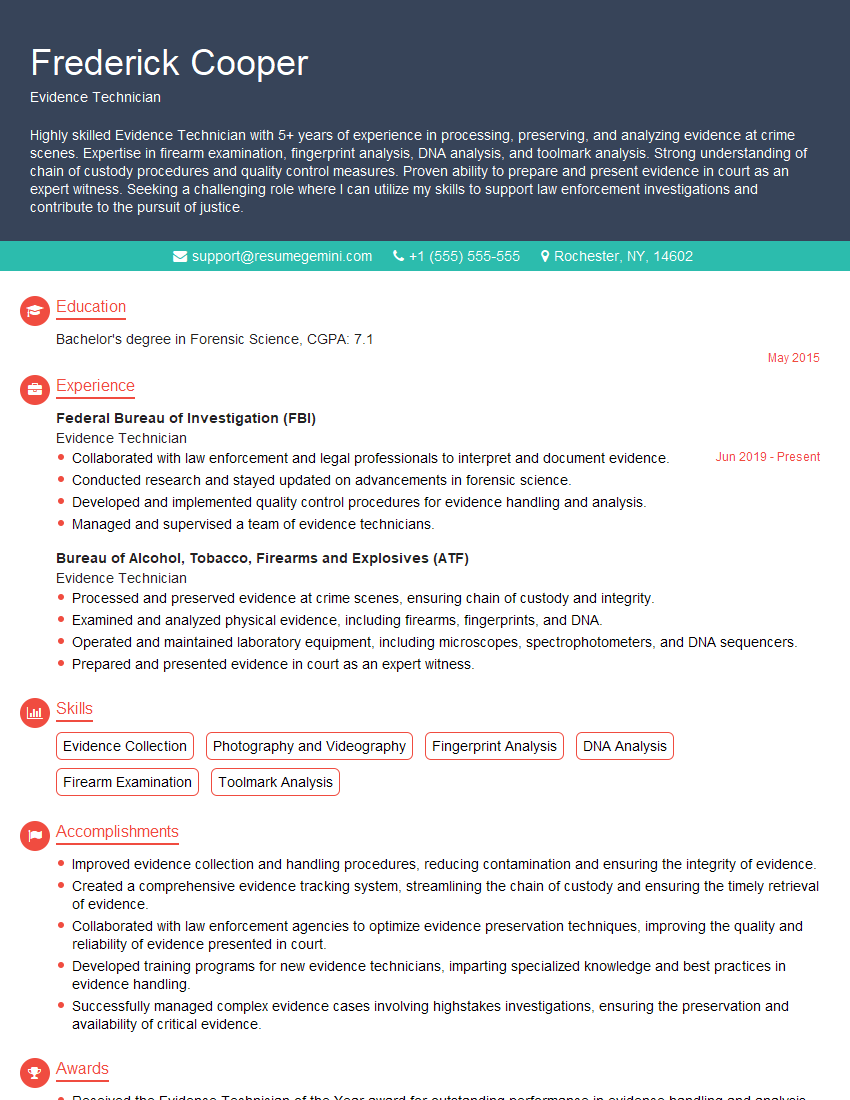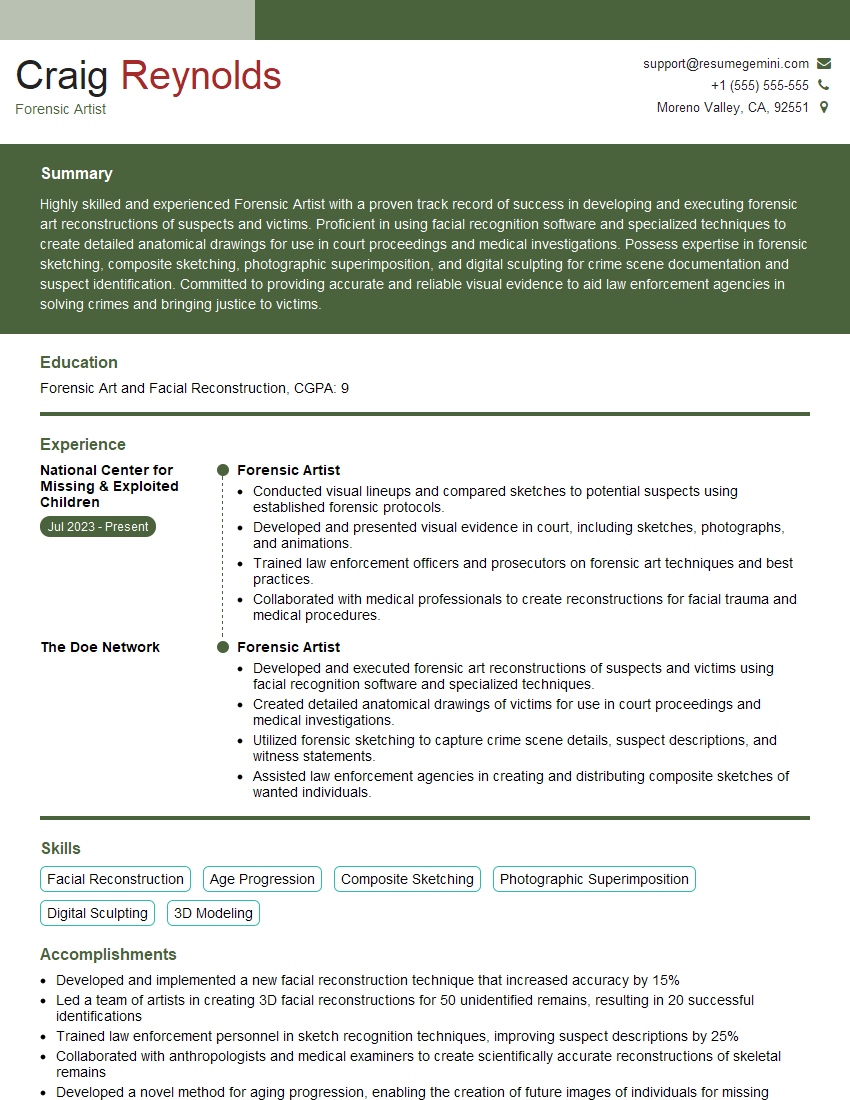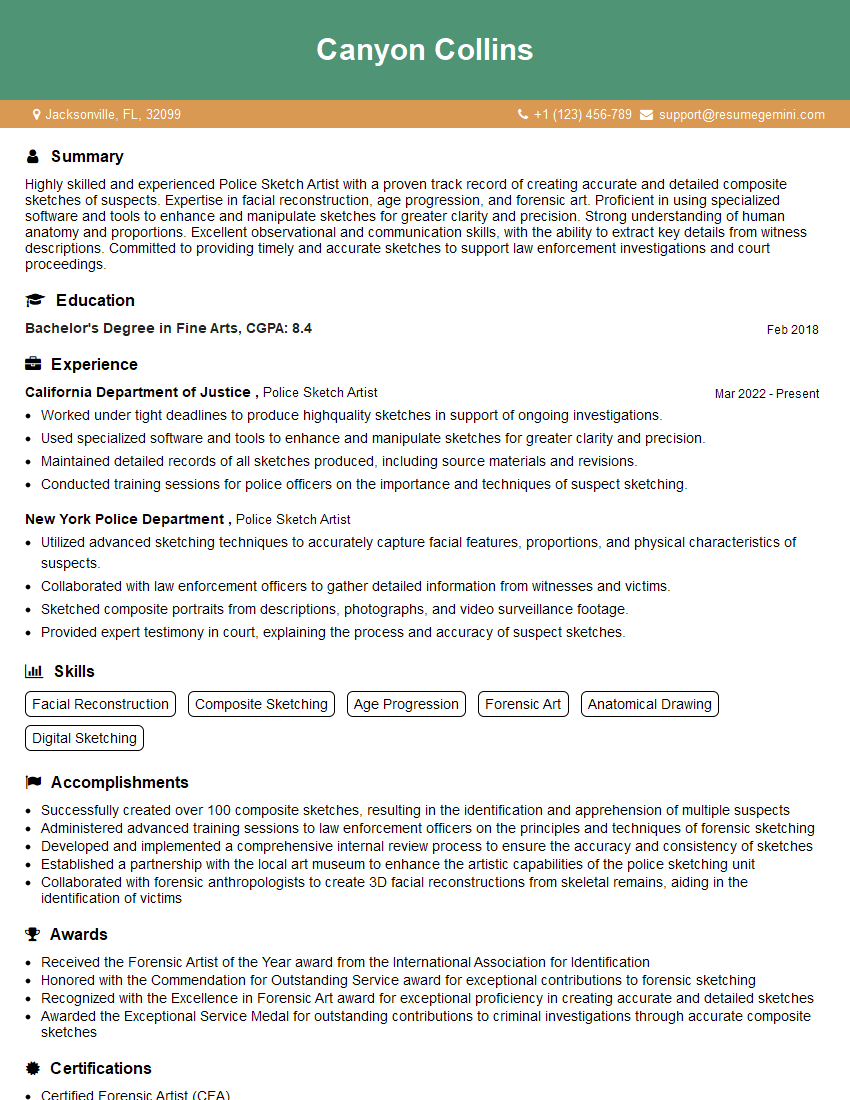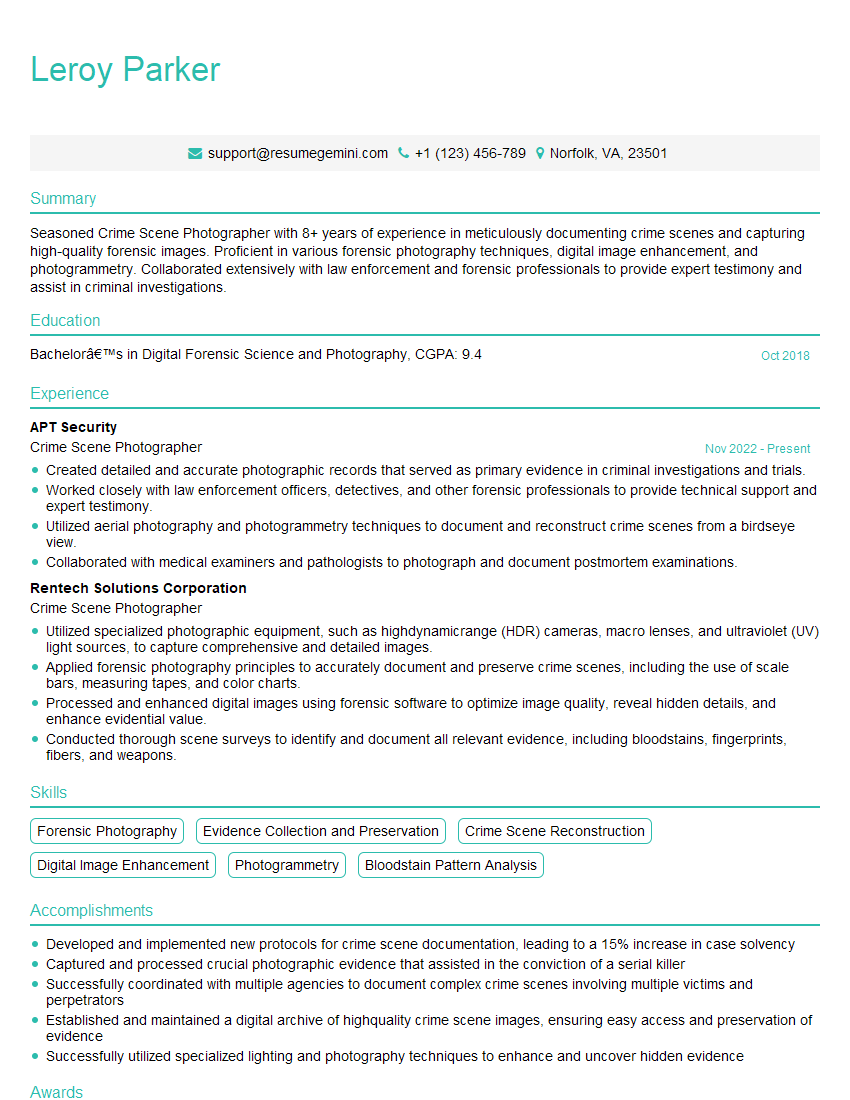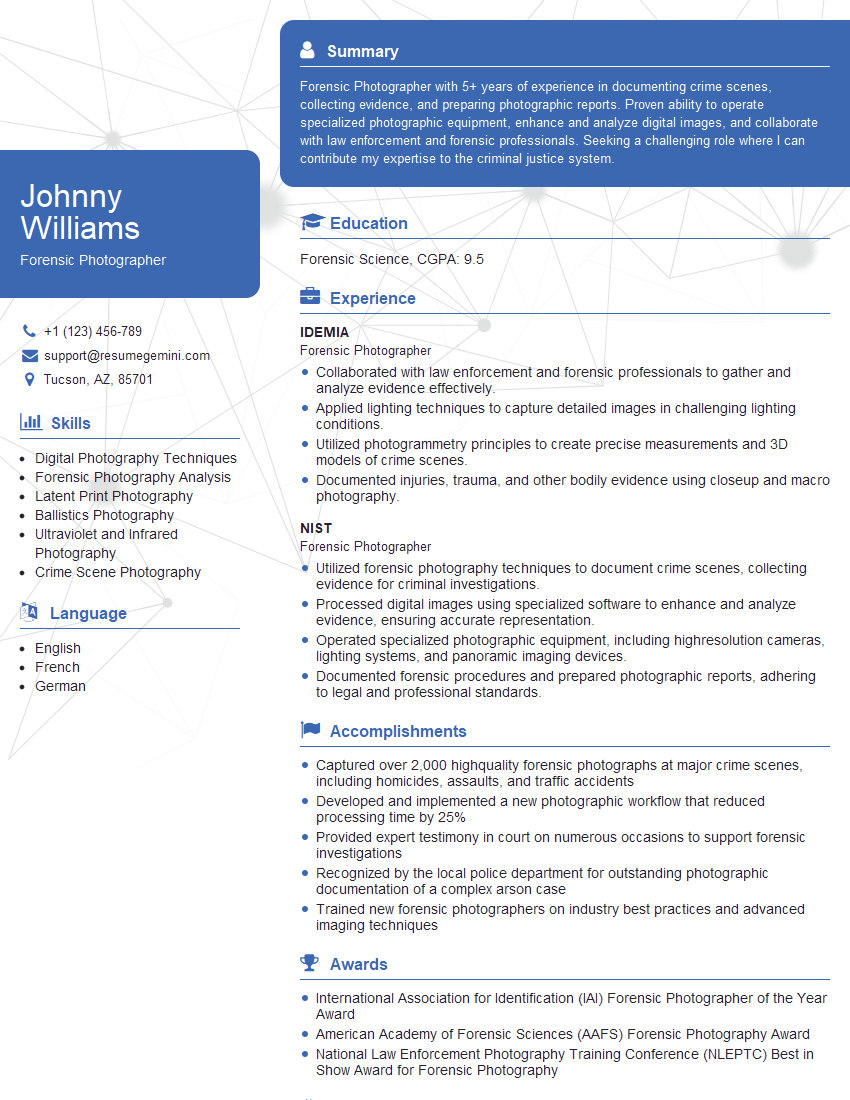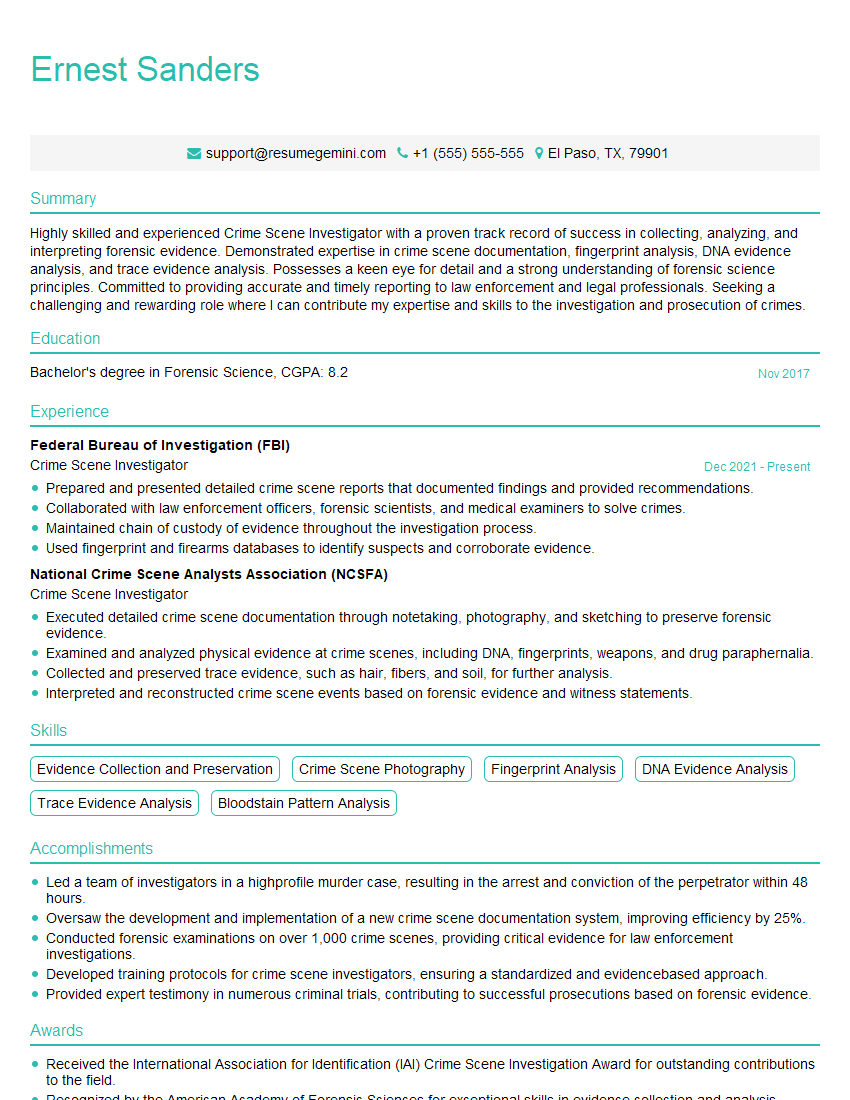Cracking a skill-specific interview, like one for Crime Scene Sketching, requires understanding the nuances of the role. In this blog, we present the questions you’re most likely to encounter, along with insights into how to answer them effectively. Let’s ensure you’re ready to make a strong impression.
Questions Asked in Crime Scene Sketching Interview
Q 1. Describe your experience with different sketching methods (e.g., perspective, isometric, exploded views).
Crime scene sketching employs various methods to accurately represent the scene. Perspective sketching provides a realistic three-dimensional view, creating depth and scale, ideal for outdoor scenes or large interiors. Think of it like taking a photograph – it shows the scene as you see it. Isometric sketching uses a 30-degree angle for all lines, resulting in a slightly distorted but easily measurable representation. This method is excellent for interior spaces and detailed layouts. Finally, exploded views are used to show the relationship between objects, often focusing on specific areas of evidence. Imagine a cutaway view of a room, highlighting the position of a weapon relative to the victim. My experience encompasses all three, and the selection depends heavily on the specifics of the crime scene.
For example, in a case involving a hit-and-run, a perspective sketch would best capture the overall road layout and vehicle position. However, to precisely show the damage to the vehicle and the point of impact, an exploded view would be beneficial. In a confined space like an apartment, an isometric sketch would allow for accurate measurements and placement of evidence.
Q 2. How do you ensure accuracy and scale in your crime scene sketches?
Accuracy and scale are paramount in crime scene sketching. We achieve this using precise measuring tools such as measuring tapes and laser rangefinders. Every measurement is double-checked to minimize errors. A scale is established before sketching begins—often 1:50 or 1:100—and this scale is clearly indicated on the sketch. This allows for accurate reproduction of the scene’s dimensions. To maintain accuracy, I utilize a combination of freehand sketching and the measured dimensions, often working with a grid system to ensure proportions are maintained.
For instance, if I measure a weapon’s distance from the victim as 3 meters, this distance must be accurately reflected on the sketch, respecting the chosen scale. Any discrepancy could affect the interpretation of the scene. I always include a scale bar on the sketch itself for immediate verification of proportions.
Q 3. Explain your process for documenting evidence and its location within a crime scene sketch.
Documenting evidence involves meticulous detail. Each item of evidence is assigned a unique number, and its exact location is pinpointed using measurements from fixed reference points within the scene (e.g., corners of a room, doorways). These measurements are clearly marked on the sketch, and a legend is included to identify each piece of evidence. The type of evidence, its size, and any distinguishing features are also noted. This ensures that every item can be precisely located during reconstruction and further investigation. Photography complements the sketch, and both work together to create a complete record.
For example, a bloodstain might be labeled ‘Evidence #3’ and its position indicated as ‘2.5 meters from the north wall and 1.2 meters from the west wall’. The legend would then specify that Evidence #3 is a bloodstain, indicating the size and any unique characteristics. It’s a highly systematic process to avoid ambiguity.
Q 4. What software or tools do you use for digital crime scene sketching?
While traditional hand-drawn sketches remain essential for their immediacy and portability, I also utilize digital sketching software. Popular options include AutoCAD, SketchUp, and specialized forensic software packages. These programs allow for greater precision, easy modification, and seamless integration with other digital forensic tools. They also facilitate the creation of scaled drawings and the incorporation of photographs. In some instances, 3D modeling software can be useful for creating a virtual reconstruction of the scene, especially in complex cases. The chosen tool depends on the complexity of the scene and the available resources.
For instance, AutoCAD’s precision tools are helpful for creating accurate floor plans, while SketchUp’s 3D modeling capabilities allow for the creation of a more immersive representation of the scene, aiding in visualization and analysis.
Q 5. How do you handle complex crime scenes with multiple points of evidence?
Complex scenes require a methodical approach. I start by systematically dividing the scene into smaller, manageable sections. Each section is sketched separately, ensuring meticulous measurement and documentation of evidence. A key is to establish a clear reference point for all measurements within each section. Once individual sections are completed, they’re integrated into a comprehensive sketch of the entire scene, often using a combination of different sketching techniques. A detailed legend is crucial to prevent confusion, and the sketches are carefully annotated to maintain clarity.
Imagine a large warehouse with multiple points of entry and scattered evidence. I would divide the warehouse into sections – perhaps by aisles – and sketch each section individually. Each section would have its own reference points and comprehensive evidence documentation, before ultimately integrating all sections into a full-scale scene drawing.
Q 6. Describe your experience with evidence photography and its integration with sketching.
Evidence photography and sketching are complementary. Photography captures the overall scene and the finer details of evidence. The sketch, however, provides a concise, scaled overview of the scene and the spatial relationships between evidence items. The sketch often incorporates annotations that reference the photographs (e.g., ‘See Photo #5 for detail of Evidence #2’). In essence, photography provides the visual detail, and the sketch provides the spatial context. Both are crucial for accurate and comprehensive documentation, and using them together ensures no detail is overlooked.
For example, photography might showcase the texture and color of a bloodstain, while the sketch shows its precise location within the room, relative to other evidence. They together tell a more complete story.
Q 7. How do you maintain the chain of custody for your sketches and related documentation?
Maintaining the chain of custody is critical to ensure the admissibility of the sketch as evidence. This involves meticulous record-keeping. Every person who handles the sketch signs and dates a log, noting the date, time, and reason for access. The sketch itself is often labeled with a unique case number and a sequential number, and it is stored in a secure, controlled environment. Digital sketches are secured with passwords and kept on encrypted drives. This ensures that the integrity and authenticity of the sketch are preserved throughout the investigation and any subsequent legal proceedings.
Proper chain of custody documentation is as important as the sketch itself. A break in the chain could compromise the admissibility of the evidence in court, undermining the entire investigation.
Q 8. What are the ethical considerations in creating crime scene sketches?
Ethical considerations in crime scene sketching are paramount. Accuracy is the cornerstone; any misrepresentation, however unintentional, can severely compromise a case. This means meticulously recording the scene as it was found, without altering or adding elements. Maintaining objectivity is crucial – personal biases or assumptions should never influence the sketch. Confidentiality is also key; the sketch should only be shared with authorized personnel involved in the investigation. Furthermore, we must be mindful of the dignity of victims and their families, avoiding gratuitous depictions of trauma or sensitive details. Think of it like this: the sketch is a visual testament, and its integrity is essential for justice.
- Accuracy: Every item must be placed precisely, reflecting actual measurements and spatial relationships.
- Objectivity: Avoid subjective interpretations or additions.
- Confidentiality: Protect the sketch from unauthorized access.
- Respect: Handle the depiction of victims and their families with sensitivity.
Q 9. Explain your understanding of perspective and its importance in crime scene reconstruction.
Perspective in crime scene sketching is the art of representing three-dimensional space on a two-dimensional surface. It’s vital because it allows investigators to grasp the spatial relationships between objects and the overall layout of the scene. We primarily use two perspectives: one-point perspective (simpler, showing depth from a single vanishing point) and two-point perspective (more complex, showing depth from two vanishing points, ideal for corner views). For example, in a robbery, one-point perspective might show a clear line of sight from the entry point to the location of stolen goods, while two-point perspective might be used to show the interior layout of a room where an assault occurred. Choosing the right perspective dramatically impacts the sketch’s clarity and usefulness in reconstructing the crime.
The choice of perspective depends on the complexity of the scene and the information to be conveyed. Simple scenes may require only one-point perspective, whereas complex scenes benefit from two-point or even three-point perspective (for greater depth and realism). A clear perspective ensures accurate measurements can be interpreted and provides a clear understanding of the scene’s spatial relationships during the reconstruction process.
Q 10. How do you incorporate witness testimony into your crime scene sketches?
Witness testimony is invaluable in creating a comprehensive and accurate crime scene sketch. I incorporate it by meticulously recording their descriptions of the event and the location of objects. For example, a witness might describe the position of a suspect relative to a specific piece of furniture. I will then use this information to locate that furniture accurately and place the suspect in the sketch accordingly. If there are discrepancies between witness accounts, I note these differences and depict them as separate potential scenarios in the sketch using different colours or labeling, so that investigators can analyze the variations and potential contradictions. Remember, a witness’s perception is subjective, and multiple accounts enrich the investigative process.
I might use different symbols or colors to distinguish information from various witness accounts, adding clarity and facilitating analysis. Crucially, I clearly document the source of this information in the sketch’s legend, ensuring transparency and traceability of the data.
Q 11. What are the limitations of crime scene sketches, and how do you address them?
Crime scene sketches have limitations. They’re static representations; they don’t capture the dynamic nature of a crime or show the temporal sequence of events. They also can’t convey smells, sounds, or subtle details like the condition of the ground. And, of course, the accuracy of the sketch relies entirely on the accuracy of measurements and observations made at the scene. To address these limitations, I always supplement sketches with photographs, videos, and detailed notes. The combined evidence creates a more comprehensive and accurate record of the crime scene than any single method could provide. Think of the sketch as one piece of a larger puzzle, not the whole picture.
Furthermore, I use additional techniques such as exploded views or cross-sections to display hidden aspects of the scene, effectively addressing limitations in representing complex three-dimensional spaces on a two-dimensional plane. Clear labeling and detailed notes are essential to overcome the limitations of static imagery.
Q 12. How do you adapt your sketching techniques to different types of crime scenes (e.g., indoor, outdoor, vehicular)?
Adapting sketching techniques to different crime scenes requires flexibility. Indoor scenes often necessitate detailed depictions of room layouts, furniture placement, and the precise location of evidence. I use precise measurements and often utilize two-point perspective for accurate representation. Outdoor scenes demand attention to landscaping, natural features, and the surrounding environment. I might use aerial perspectives to show the overall area and then detailed views of specific locations. Vehicular scenes require careful attention to the vehicle’s interior and exterior, noting damage, bullet holes, and the position of occupants. In all cases, clear and concise labeling ensures understanding of the context and location of each feature.
For example, an indoor scene might require measuring the room dimensions and the distances between key objects. An outdoor scene might need the use of landmarks and compass directions to properly orient the sketch, including scale and north orientation. Vehicular scenes often call for creating detailed sketches of the vehicle’s interior and exterior, and the position of any bodies within it.
Q 13. Explain your process for creating a key or legend for your crime scene sketch.
Creating a clear and comprehensive key or legend is crucial for interpreting a crime scene sketch. I use a standardized format, usually a table, listing all symbols, abbreviations, and colors used, and clearly define what each represents. For example, a small circle might represent a bullet casing, a square might indicate a bloodstain, and specific colors might code different types of evidence. I include units of measurement (e.g., centimeters or inches) and a scale to indicate the relationship between the sketch’s dimensions and the actual scene. Each entry should be precise and unambiguous, avoiding any chance of misinterpretation. The legend is placed on the sketch itself, usually in a corner or on a separate sheet, ensuring easy reference.
I use a consistent and easily understood style for each symbol, avoiding ambiguity. For example, I might use a standard symbol library for consistency across multiple cases, creating a standardized reference that reduces errors and enhances collaboration.
Q 14. How do you handle obstructed views or areas of limited visibility in a crime scene?
Obstructed views or areas of limited visibility present challenges. I address them by using techniques like dashed lines or shading to indicate areas that were not directly visible. If only a portion of an object is visible, I indicate this in the sketch, often with notes specifying the visible and invisible parts. For example, if a body is partially hidden behind a curtain, I will show the visible portion accurately and use dashed lines to suggest the unseen portions. I meticulously document why certain areas are obscured (e.g., due to debris, shadows, or obstructions) and provide annotations explaining the limitations.
I also might incorporate multiple sketches to show the scene from different viewpoints to provide a more complete picture. Where possible, I’ll use notes and photos to supplement the information, creating a composite record that accounts for the limitations of visibility. Transparency about limitations is crucial; concealing gaps in information can be misleading and compromise the investigation.
Q 15. Describe your experience using different types of measuring tools in a crime scene.
Accurate measurements are the backbone of a reliable crime scene sketch. Over my years of experience, I’ve utilized a variety of tools, each suited to different tasks and environments. For instance, a standard measuring tape is indispensable for measuring distances between objects, the dimensions of rooms, and the lengths of trails of evidence. I also rely heavily on laser measuring tools for faster and more precise measurements, especially in larger spaces or when working with difficult-to-access areas. For smaller, more intricate items, I might use calipers or a ruler with millimeter markings to ensure the minutest details are recorded accurately. Finally, I utilize a tripod-mounted camera with a known focal length for photogrammetry, which allows for highly precise 3D modeling and measurements – invaluable for complex scenes. The choice of measuring tool is always dictated by the specific requirements of the crime scene.
For example, in a case involving a hit-and-run, I might use a laser measurer to determine the skid marks’ length and the distance between the vehicle’s final resting point and the victim. In a smaller, indoor crime scene like a homicide, I might switch to a combination of measuring tape and calipers for precise measurements of furniture placement, wound dimensions, and weapon location.
Career Expert Tips:
- Ace those interviews! Prepare effectively by reviewing the Top 50 Most Common Interview Questions on ResumeGemini.
- Navigate your job search with confidence! Explore a wide range of Career Tips on ResumeGemini. Learn about common challenges and recommendations to overcome them.
- Craft the perfect resume! Master the Art of Resume Writing with ResumeGemini’s guide. Showcase your unique qualifications and achievements effectively.
- Don’t miss out on holiday savings! Build your dream resume with ResumeGemini’s ATS optimized templates.
Q 16. How do you ensure the clarity and readability of your crime scene sketches?
Clarity and readability are paramount. A poorly rendered sketch is useless in court. I achieve this through a combination of careful planning and execution. I begin with a consistent scale, usually a standard 1:50 or 1:100, depending on the size of the scene. I use clear, concise lettering for labels and annotations, employing a consistent font and size throughout. Different line weights help distinguish between different elements—solid lines for walls, dashed lines for suggested trajectories, and dotted lines for items of uncertain placement. I utilize standard symbols for common objects to save time and enhance understanding (e.g., a circle for a bloodstain, a square for a piece of evidence). Finally, I use a north arrow and a legend clearly defining all symbols and abbreviations to ensure complete understanding. I always keep in mind the intended audience – whether it’s law enforcement, a jury, or a forensic expert.
For instance, using different colors to highlight specific evidence, like blood spatter or a weapon, aids clarity. It’s all about creating a visually engaging and easy-to-interpret record of the scene.
Q 17. Explain your proficiency in using CAD software for crime scene reconstruction.
CAD software is an invaluable tool in modern crime scene reconstruction. My proficiency encompasses several programs, including AutoCAD and SketchUp. I can efficiently import data from various sources like photographs, laser scans, and measurements to create accurate 3D models. I’m adept at using CAD tools to create detailed floor plans, elevations, and cross-sections of a crime scene. I can also incorporate annotations, measurements, and evidence markers directly onto the 3D model, enhancing the visual representation and assisting with analysis. This allows for a more thorough examination of the scene, enabling investigators to explore various scenarios and theories. It also assists in the creation of animations and virtual walkthroughs for presentations and court proceedings.
For example, I can recreate a car accident scene in 3D, showing the trajectory of vehicles, point of impact, and the resulting damage. This is incredibly helpful for accident reconstruction experts.
Q 18. How do you create accurate scale drawings from measurements taken at a crime scene?
Creating accurate scale drawings is a crucial aspect of my work. The process begins with meticulous measurement at the scene using the appropriate tools. Once all the measurements are gathered, I establish a scale, ensuring the drawing’s size is manageable yet detailed enough. I prefer to work using a consistent scale throughout the sketch. I then use graph paper or CAD software to translate the measurements onto the drawing medium. Each measurement is carefully transferred and checked for consistency. I use a legend to denote the scale used and any significant details.
For instance, if the scale is 1:50, every centimeter on the drawing represents 50 centimeters at the crime scene. I consistently check that all elements maintain this ratio.
Q 19. What are the legal implications of inaccurate or incomplete crime scene sketches?
Inaccurate or incomplete crime scene sketches can have serious legal implications. They can undermine the credibility of the investigation and potentially lead to wrongful convictions or acquittals. An inaccurate sketch might misrepresent the spatial relationships between objects, leading to flawed interpretations of events. Missing crucial details can omit vital evidence, hindering the prosecution’s or defense’s case. In court, an expert can challenge the sketch’s accuracy and validity, potentially impacting the jury’s understanding of the case. This highlights the importance of extreme care and precision in the sketching process to ensure legal soundness and integrity.
For example, an inaccurate representation of a weapon’s position relative to the victim could drastically alter the reconstruction of the events.
Q 20. Describe your understanding of different types of evidence and how you would represent them in a sketch.
Understanding the various types of evidence and their accurate representation is critical. I categorize evidence into different types such as trace evidence (e.g., hair, fibers), biological evidence (blood, DNA), ballistic evidence (bullets, shell casings), and impression evidence (footprints, tire tracks). Each requires a specific method of representation in the sketch. For instance, blood spatters are shown using standardized symbols with size indicators. Weapons are outlined in detail, indicating their position and orientation. Trace evidence might be indicated with small symbols and labeled appropriately. I use different colors and line styles to differentiate these types of evidence to enhance clarity.
Imagine a burglary; I would represent the point of entry, the location of broken locks, the path taken by the intruder, and the location of any stolen items all clearly and distinctly.
Q 21. How do you incorporate measurements and annotations accurately into your sketches?
Accurate incorporation of measurements and annotations is achieved through a systematic approach. Measurements are written directly onto the sketch, clearly indicating the points between which they are taken. I use leader lines to connect measurements to their corresponding objects or points on the sketch to avoid confusion. Annotations are concise, clear, and accurately positioned. I use a standardized font and size for consistency. A key is always included to explain any abbreviations or symbols used. The entire process is meticulously checked for accuracy before finalization.
For example, ‘Window 1 – Broken, 1.8m from ground’ would be written clearly next to the window’s depiction with a leader line pointing to the measurement point.
Q 22. How do you manage the workflow for multiple crime scene sketches on a single case?
Managing multiple sketches for a single case involves a systematic approach. Think of it like building a story with multiple chapters – each sketch represents a crucial scene or viewpoint. I begin by assigning a unique identifier to each sketch, like “Sketch A – Victim’s Position,” “Sketch B – Entry Point,” or “Sketch C – Weapon Location.” This ensures clear organization and avoids confusion during the investigation and later presentation. I also create a detailed log linking each sketch to its corresponding notes and photographs. This log acts as a roadmap, allowing easy retrieval and referencing of specific elements. For example, if the court asks about the positioning of a specific piece of evidence, I can quickly pinpoint the relevant sketch and supporting documentation. Using a case management system, either digital or physical, further helps in maintaining the integrity and traceability of all sketches related to the case.
Furthermore, I use consistent conventions across all sketches, including scale, legend, and directional indicators. This ensures uniformity and consistency, making it easier to compare and contrast the different scenes. For complex cases, I might even prepare an overview sketch that integrates key elements from the individual sketches, providing a holistic view of the crime scene.
Q 23. Explain your experience presenting your crime scene sketches in court.
Presenting crime scene sketches in court requires meticulous preparation and clear communication. I ensure that every sketch is accurate, properly scaled, and clearly labeled, which builds credibility and clarity. I use large, high-quality prints, often with annotations highlighting key evidence or points of interest. Think of it like telling a visual story. Before the presentation, I thoroughly review the sketch with the prosecution or defense team to anticipate potential questions and adjust my approach accordingly. During my testimony, I explain the purpose of each sketch, describe the sketching process, and answer questions concerning details, perspectives, and methodology. I use simple, non-technical language whenever possible to avoid confusing the jury or judge. In several cases, I’ve successfully used my sketches to visually demonstrate crucial elements, like the trajectory of a projectile, leading to more effective understanding and ultimately affecting the outcome of the case.
Q 24. Describe your understanding of the importance of maintaining the integrity of the crime scene during sketching.
Maintaining the integrity of the crime scene is paramount during sketching. My role isn’t just about creating accurate drawings; it’s about contributing to the overall preservation of evidence. I follow strict protocols, including never moving or altering evidence, only observing and meticulously documenting it in my sketch. I work in coordination with other forensic specialists, especially photographers, to ensure that our work doesn’t interfere with each other’s. The photographer might capture overall views, while I focus on detailed depictions of specific areas or objects. We constantly communicate to ensure a complete and accurate record of the scene. This collaborative approach ensures that nothing is overlooked and that the integrity of the crime scene remains uncompromised. Any action that could potentially contaminate or destroy evidence is avoided.
Q 25. How do you handle changes or updates to a crime scene sketch after initial creation?
Changes or updates to a sketch after initial creation are handled through a documented amendment process. I never erase or alter the original sketch. Instead, I create a new version, clearly marked as an amendment, indicating the date and nature of the changes. The process is similar to the version control you see in software development – I retain all previous versions, documenting all changes. This ensures transparency and accountability. For instance, if new evidence is discovered, I would add it to a new version of the sketch, while the original remains as a record of the initial state of the scene. This approach is vital for maintaining the chain of custody and avoiding any accusations of tampering or misrepresentation.
Q 26. How do you prioritize details and information when creating a crime scene sketch with limited time?
Prioritizing information in time-constrained situations requires a strategic approach. I focus first on the key elements that establish the overall context: the layout of the room, the locations of major evidence items, and the relative positions of bodies or significant objects. This is often followed by adding secondary details such as furniture or minor evidence. Using symbols and abbreviations in the sketch’s legend significantly helps to save time and space. I prioritize elements relevant to the suspected crime and the overall narrative. For instance, if it’s a homicide, the position of the victim, weapon, and entry/exit points take precedence. This allows for a quick, yet comprehensive, representation of the essential details for initial investigation and later analysis. Less critical details can be added later if time permits.
Q 27. Explain your experience working with other forensic specialists (e.g., investigators, photographers) during a crime scene investigation.
Collaboration with other forensic specialists is essential for a complete and accurate crime scene reconstruction. I maintain open communication with investigators, photographers, and other experts throughout the process. The photographer usually provides high-resolution images, while I work to create detailed sketches that complement their work. I might be involved in discussions concerning positioning of evidence, and my sketches can assist in determining the sequence of events. This collaborative effort ensures consistency and minimizes the chance of errors or omissions. For example, a detective’s insights into the possible timeline of events might inform my sketching choices, while my sketch would in turn visually clarify complex aspects of the scene for the detective’s report. This teamwork is crucial for a well-rounded forensic investigation.
Q 28. How do you adapt your sketching techniques to accommodate specific requests from investigators or legal counsel?
Adapting my sketching techniques to specific requests depends on the nature of the request and the legal context. Investigators often request specific views or details to support their theories, while legal counsel might need sketches for courtroom presentations or visual aids for expert testimony. I might be asked to create a bird’s-eye view, a cross-section, or a detailed depiction of a particular object. I make sure to satisfy these requests while always adhering to the principles of accuracy and objectivity. The key is open communication and a clear understanding of the intended purpose of the sketch. For example, if the defense requires a sketch emphasizing the lack of forced entry, I can produce that, whilst also maintaining a complete and unaltered depiction of the overall scene.
Key Topics to Learn for Crime Scene Sketching Interview
- Basic Sketching Techniques: Mastering perspective, scale, and proportion for accurate crime scene representation. Practical application: Creating accurate sketches from various angles and distances.
- Evidence Documentation: Thorough and systematic recording of evidence location, type, and condition within the sketch. Practical application: Using symbols and legends to clearly identify different types of evidence.
- Sketching Software and Tools: Familiarity with CAD software and other digital tools used in crime scene sketching. Practical application: Understanding the advantages and limitations of various software options and their application in different crime scenes.
- Legal and Ethical Considerations: Adherence to legal guidelines and ethical standards during the sketching process. Practical application: Ensuring sketches are admissible as evidence in court.
- Crime Scene Photography Integration: Coordinating sketches with crime scene photographs for comprehensive documentation. Practical application: Understanding the relationship between photographic evidence and the corresponding sketch.
- Different Types of Sketches: Understanding the application of various sketch types (e.g., overview, detailed, exploded) based on crime scene complexity. Practical application: Selecting the appropriate sketch type for different scenarios.
- Problem-Solving and Critical Thinking: Analyzing complex crime scenes and determining the most effective sketching approach. Practical application: Developing strategies for visualizing and representing challenging crime scenes accurately.
Next Steps
Mastering crime scene sketching is crucial for career advancement in forensic science and law enforcement, opening doors to specialized roles and enhanced professional credibility. To maximize your job prospects, crafting a compelling and ATS-friendly resume is essential. ResumeGemini is a trusted resource to help you build a professional resume that showcases your skills and experience effectively. We provide examples of resumes tailored specifically to crime scene sketching to guide you in creating a standout application. Take the next step towards your dream career – build your best resume with ResumeGemini.
Explore more articles
Users Rating of Our Blogs
Share Your Experience
We value your feedback! Please rate our content and share your thoughts (optional).
What Readers Say About Our Blog
Hello,
We found issues with your domain’s email setup that may be sending your messages to spam or blocking them completely. InboxShield Mini shows you how to fix it in minutes — no tech skills required.
Scan your domain now for details: https://inboxshield-mini.com/
— Adam @ InboxShield Mini
Reply STOP to unsubscribe
Hi, are you owner of interviewgemini.com? What if I told you I could help you find extra time in your schedule, reconnect with leads you didn’t even realize you missed, and bring in more “I want to work with you” conversations, without increasing your ad spend or hiring a full-time employee?
All with a flexible, budget-friendly service that could easily pay for itself. Sounds good?
Would it be nice to jump on a quick 10-minute call so I can show you exactly how we make this work?
Best,
Hapei
Marketing Director
Hey, I know you’re the owner of interviewgemini.com. I’ll be quick.
Fundraising for your business is tough and time-consuming. We make it easier by guaranteeing two private investor meetings each month, for six months. No demos, no pitch events – just direct introductions to active investors matched to your startup.
If youR17;re raising, this could help you build real momentum. Want me to send more info?
Hi, I represent an SEO company that specialises in getting you AI citations and higher rankings on Google. I’d like to offer you a 100% free SEO audit for your website. Would you be interested?
Hi, I represent an SEO company that specialises in getting you AI citations and higher rankings on Google. I’d like to offer you a 100% free SEO audit for your website. Would you be interested?
good
